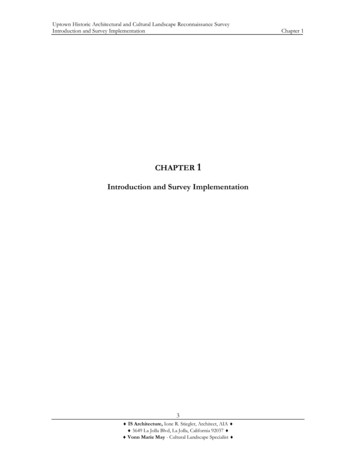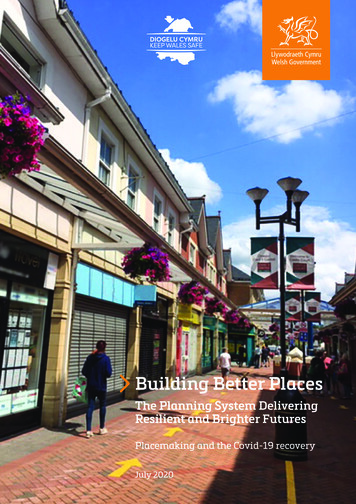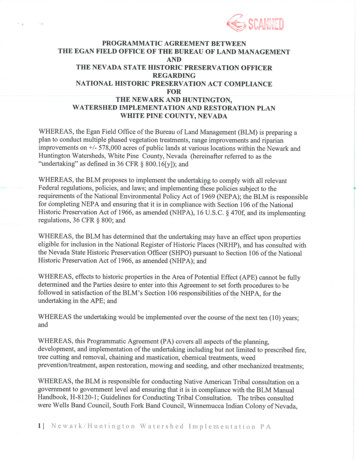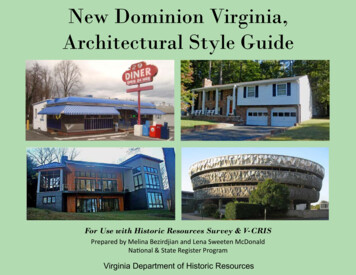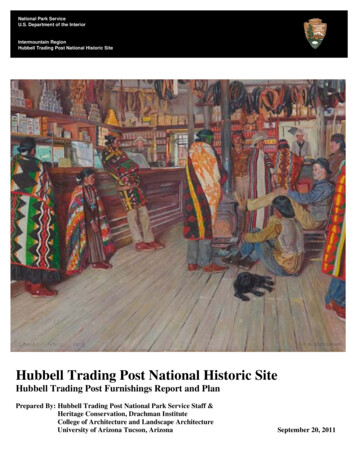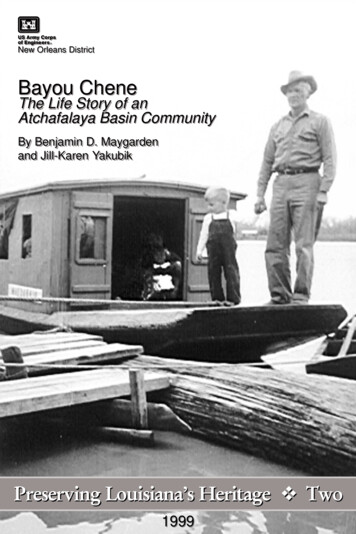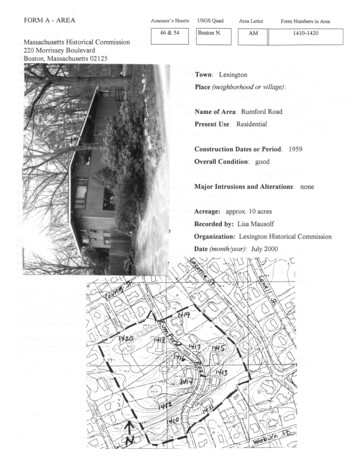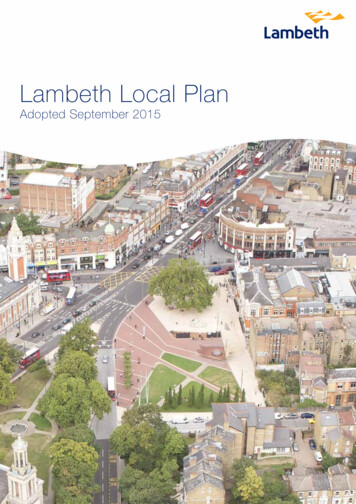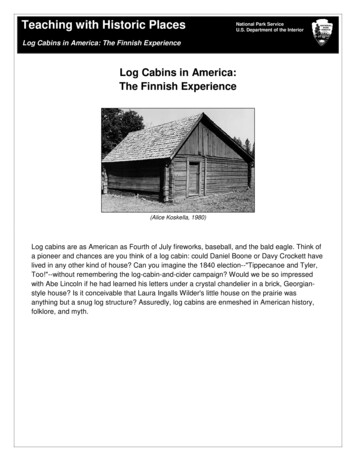
Transcription
Teaching with Historic PlacesNational Park ServiceU.S. Department of the InteriorLog Cabins in America: The Finnish ExperienceLog Cabins in America:The Finnish Experience(Alice Koskella, 1980)Log cabins are as American as Fourth of July fireworks, baseball, and the bald eagle. Think ofa pioneer and chances are you think of a log cabin: could Daniel Boone or Davy Crockett havelived in any other kind of house? Can you imagine the 1840 election--"Tippecanoe and Tyler,Too!"--without remembering the log-cabin-and-cider campaign? Would we be so impressedwith Abe Lincoln if he had learned his letters under a crystal chandelier in a brick, Georgianstyle house? Is it conceivable that Laura Ingalls Wilder's little house on the prairie wasanything but a snug log structure? Assuredly, log cabins are enmeshed in American history,folklore, and myth.
Teaching with Historic PlacesNational Park ServiceU.S. Department of the InteriorLog Cabins in America: The Finnish ExperienceDocument ContentsNational Curriculum StandardsAbout This LessonGetting Started: Inquiry QuestionSetting the Stage: Historical ContextLocating the Site: Map1. Map 1: Finnish speaking population, 1920Determining the Facts: Readings1. Reading 1: The Log Cabin Tradition2. Reading 2: Long Valley Finnish Structures3. Reading 3: Log Cabin PoliticsVisual Evidence: Images1. Drawing 1: Log corner notching systems.2. Photo 1: Detail of northeast corner, Jacob and Herman Mahala Homestead, Long Valley,Idaho.3. Photo 1a: Exterior wall detail, Gust Laituri Homestead, Long Valley, Idaho.4. Photo 2: Teacher's cottage for Elo School, Long Valley, Idaho.5. Photo 3: Goat Barn, John G. Johnson (Rintakangas) Homestead, Long Valley, Idaho6. Photo 4: Log barn, Nickolai Wargelin Homestead, Long Valley, Idaho.7. Photo 5: Sauna, John G. Johnson (Rintakangas) Homestead, Long Valley, Idaho.Putting It All Together: Activities1. Activity 1: Folk Housing2. Activity 2: Role Play3. Activity 3: Modern Log HousingReferences and Endnotes
Teaching with Historic PlacesLog Cabins in America: The Finnish ExperienceAdditional ResourcesNational Park ServiceU.S. Department of the Interior
Teaching with Historic PlacesNational Park ServiceU.S. Department of the InteriorLog Cabins in America: The Finnish ExperienceWhere this lesson fits into the curriculumTime Period: 1700s-1900sTopics: This lesson could be used in teaching units on the development of the early colonies,trans-Appalachian settlement, or late 19th- and early 20th-century immigration.Relevant United States History Standards for Grades 5-12This lesson relates to the following National Standards for History from the UCLA NationalCenter for History in the Schools:US History Era 4: Standard 3A: The student understands the changing character of American politicallife in "the age of the common man."US History Era 6: Standard 2A: The student understands the sources and experiences of the newimmigrants. Standard 2C: The student understands how new cultural movements at differentsocial levels affected American life.US History Era 7: Standard 1B: The student understands Progressivism at the national level.Relevant Curriculum Standards for Social StudiesThis lesson relates to the following Curriculum Standards for Social Studies from the NationalCouncil for the Social Studies:Theme I: Culture Standard C: The student explains and gives examples of how language,literature, the arts, architecture, other artifacts, traditions, beliefs, values, andbehaviors contribute to the development and transmission of culture.Theme III: People, Places, and Environment
Teaching with Historic PlacesNational Park ServiceU.S. Department of the InteriorLog Cabins in America: The Finnish Experience Standard H: examine, interpret, and analyze physical and cultural patternsand their interactions, such as land use, settlement patterns, culturaltransmission of customs and ideas, and ecosystem changes.Theme VIII: Science, Technology, and Society Standard A: The student examines and describes the influence of culture onscientific and technological choices and advancement, such as intransportation, medicine, and warfare.Relevant Common Core StandardsThis lesson relates to the following Common Core English and Language ArtsStandards for History and Social Studies for middle school and high school students:Key Ideas and Details CCSS.ELA-LITERACY.RH.6-8.2Craft and Structure CCSS.ELA-LITERACY.RH.6-8.6Integration of Knowledge and Ideas CCSS.ELA-LITERACY.RH.6-8.7Range of Reading and Level of Text Complexity CCSS.ELA-LITERACY.RH.6-8.10
Teaching with Historic PlacesNational Park ServiceU.S. Department of the InteriorLog Cabins in America: The Finnish ExperienceAbout This LessonThis lesson is based on the National Register of Historic Places registration files "Long ValleyFinnish Structures," 166.pdf] visitor'sguides to several western parks, and other sources. It was published in 2001.This lesson waswritten by Fay Metcalf, an education consultant. It was edited by Teaching with Historic Placesstaff. This lesson is one in a series that brings the important stories of historic places intoclassrooms across the country.Objectives1. To explain the distinctive features of log structures built by Finnish homesteaders in Idaho.2. To explain how Finns and Swedes influenced the techniques used for building logstructures.3. To describe how the log cabin became so widely used among colonists and later pioneers.4. To investigate the student's own locality to find out what kind of folk housing was prevalentin their own community.Materials for studentsThe materials listed below can either be used directly on the computer or can be printedout, photocopied, and distributed to students.1. One map showing the location of Finnish speakers;2. Three readings which examine the origins of log structures and their adoption by theAmerican public as a symbol of self-reliance and virtue;3. One drawing and two photos of notching systems and cabin details;4. Four photos different log structures built by the Finnish in Long Valley, Idaho.Visiting the siteThe Finnish log structures discussed in this lesson are located off Highway 55 (some onunimproved, some on unnamed, roads) in the vicinity of Donnelly, Idaho. They are privatelyowned and not open to the public. However, the nearby Southern Idaho Timber Associationbuildings are also good examples of Finnish log construction. The buildings are located at thecorner of Lake and State streets in the town of McCall and on Highway 55 in Smith's Ferry.
Teaching with Historic PlacesNational Park ServiceU.S. Department of the InteriorLog Cabins in America: The Finnish ExperienceGetting Started(Alice Koskella, 1980)What might this be?What do you think it was used for?
Teaching with Historic PlacesNational Park ServiceU.S. Department of the InteriorLog Cabins in America: The Finnish ExperiencePhoto Analysis WorksheetStep 1:Examine the photograph for 10 seconds. How would you describe the photograph?Step 2:Divide the photograph into quadrants and study each section individually. What details--such aspeople, objects, activities--do you notice?Step 3:What other information--such as time period, location, season, reason photo was taken--canyou gather from the photo?Step 4:How would you revise your first description of the photo using the information noted in Steps 2and 3?Step 5:What questions do you have about the photograph? How might you find answers to thesequestions?
Teaching with Historic PlacesNational Park ServiceU.S. Department of the InteriorLog Cabins in America: The Finnish ExperienceSetting the StageThe log cabin has long been a symbol of American self-sufficiency. The cabin could be quickly built,and it provided a reasonably secure haven in a strange and often hostile environment. Neither arrowsnor bullets could penetrate its thick wood walls which--if well-built and carefully chinked--would keep outrain, snow, and cold. Although the cabins could catch fire, this did not happen very often. As peoplecontinued to move westward in search of more and better land, they would abandon their cabinsknowing they could easily build new ones as long as timber was available. Even in the early 20thcentury as far western lands opened up to settlement, new immigrants continued to construct logcabins as their first American homes.Under the Homestead Act of May 20, 1862, those citizens who were the head of a family or at least 21years of age were offered 160 acres of surveyed land after five years of continuous residence andpayment of a registration fee ranging from 26 to 34. Alternatively, land could be acquired at 1.25 anacre after six months' residence. By means of this act, Finnish immigrants settled in Idaho between1900 and 1930.
Teaching with Historic PlacesNational Park ServiceU.S. Department of the InteriorLog Cabins in America: The Finnish ExperienceLocating the SiteMap 1: Finnish speaking population, 1920The majority of Finnish immigrants to America from 1860 to 1900 settled in the northern portions of theU.S. where they worked as miners, loggers, or dockhands. Smaller settlements grew up in other statessuch as New York, Maine, Oregon, Montana, and Idaho.
Teaching with Historic PlacesNational Park ServiceU.S. Department of the InteriorLog Cabins in America: The Finnish ExperienceQuestions for Map 11) Locate Finland on a world map and then locate the states noted in Map 1 that have largerconcentrations of the Finnish population. Note the latitudes of the locations. Why do you think Finnishimmigrants to America did not choose to settle in the South?2) Examine Map 1. Note the location of most Finnish speakers in 1920. Compare the numbers of Finnsin Idaho with those in other parts of the nation. In which states are most of the Finnish Americanslocated?3) Considering that the largest population of Finns settled in the eastern half of the United States, whydid some Finns migrate to Idaho and other western states? (If needed, refer to Setting the Stage.)4) The cities listed on Map 1 have the ten largest Finnish population concentrations except where thepopulation of the city is less than 1,000. The population in the leading cities of settlement ranged from1,000-10,000, except in New York City which ranged from 10,001-50,000. Why do you think New YorkCity has the highest concentration of Finnish immigrants? What role did New York City play forAmerica's immigrants?5) The Finns of Idaho settled on homestead farmlands and in small towns. Examine a map of Idahoand locate Coeur d'Alene and Cabinet, and also the towns of Lake Fork, Cascade, McCall, andDonnelly. Note the elevation and the proximity of national forest lands on your map. What ways of lifemight the Finns have continued if they lived in a place like Idaho?
Teaching with Historic PlacesNational Park ServiceU.S. Department of the InteriorLog Cabins in America: The Finnish ExperienceDetermining the FactsReading 1: The Log Cabin TraditionThe origin of the log structure is uncertain. It is probable that it began in northern Europesometime in the Bronze Age (c. 3,500 B.C.). By the time Europeans began to settle in America,there was a long tradition of using logs for houses, barns, and other outbuildings in theScandinavian countries, Germany, and Northern Russia. These regions had vast stands ofsoftwood timber that could easily be worked with simple hand tools. According to historian C. A.Weslager, the Finns, as well as the Swedes, had a "close attunement" with the forests, and bothgroups had well-developed forest industries. Weslager goes on to say:The Finns were accomplished in building several forms of log housing, havingdifferent methods of corner timbering, and they utilized both round and hewn logs.Their log building had undergone an evolutionary process from the crude "pirtii".asmall gabled-roof cabin of round logs with an opening in the roof to vent smoke, tomore sophisticated squared logs with interlocking double-notch joints, the timberextending beyond the corners. Log saunas or bathhouses of this type are still foundin rural Finland.When the Finns and the Swedes began to arrive in New Sweden (along both banks of theDelaware River into modern Delaware, New Jersey, Pennsylvania and Maryland), they broughttheir knowledge of such wood construction with them. So did later immigrants from Germany.The Scots, Irish, and Scots-Irish had no tradition of building with logs, but they quickly adoptedthe technique. The log cabin suited early settlers and later pioneers. It would have been nearlyimpossible to carry building materials across the ocean in the small sailing ships of the time. Itwould have been equally difficult to transport building materials on horseback or even in thewagons or river barges pioneers used to cross mountains and valleys in their search for theirown land. So, wherever there were forested areas, the log cabin became the preferred type ofinitial dwelling. Log cabins did not even need nails or spikes to hold them together. Until the19th century nails were made by hand by blacksmiths, which meant they were quite expensive,and like lumber, they were also heavy.Log cabins were relatively easy to build. Weslager reports that a record was set by three menwho cut down trees, trimmed them, dragged the logs to the building site, notched the logs, andbuilt a one-room cabin with chimney and fireplace in two days. For most people it took a bitlonger, but it was possible for a man working alone to build a cabin in one to two weeks.However, a man alone faced some problems. Because it is physically difficult to lift a heavy logabove one's head, most men could build cabins only six to eight logs high. With help, it waspossible to build several logs higher--even two-story log houses were possible. First, skids oftwo logs were placed against the wall at an angle to serve as an inclined plane. Then forkedsticks or ropes were used to position the logs.Most log cabins had a single room, or "pen," some 12 to 16 feet square. There was one door,and usually no windows. If windows were cut into the walls, animal skins or boards were fixed toslide across the openings. Some builders used paper greased with animal fat, which made itboth translucent and waterproof. Most log cabin builders placed the fireplace at one end of thecabin and built the chimney of wattle. Stone or clay was used for the hearth and the interior ofthe fireplace. As these were not very safe constructions, later builders used brick or stone if they
Teaching with Historic PlacesNational Park ServiceU.S. Department of the InteriorLog Cabins in America: The Finnish Experiencecould be obtained. Fireplaces provided warmth, light, and fuel for cooking. Back bars andcranes made of forged iron were used to hold cooking pots. Not until the 1840s were cast-ironranges available that would burn wood or coal, so cooking over a fireplace did not seem ahardship.Inside walls were often chinked with clay or cloth. Most floors were simply beaten earth,although some cabins had floors of puncheons--logs split lengthwise and laid close togetherwith the flat sides up. A family often built a sleeping loft if the roof were high enough. The loftcould be reached by pegs pounded into the walls or by a ladder built from tree limbs. The loftalso was used to store foodstuffs.Log cabins were never meant to be permanent, but many log houses were. The differencebetween the two was primarily one of size and attention to detail. Most pioneers preferred "flat"walls to rounded log walls, and so most used hewn logs for building. These not only made thehouses look (from a distance) more "real," but also withstood the elements much better, sincethe bark and the decay-prone outside wood were removed from the logs. When milled lumberbecame available either from a local sawmill or by railroad transport, most people chose it fortheir homes.It seemed that as the frontier disappeared, so would the log cabin. However, at about the sametime the Finnish homesteaders were, of necessity, building their first homes of logs, Easternerswere rediscovering the log structure. William A. Durant, land developer and president of theAdirondack Railroad, pushed the idea of Great Camps in the Adirondacks. These camps wereenclaves where the very wealthy could escape the summer heat of the cities and retreat to the"simple life" of log-cabin living in the country. Such "cabins" were hardly simple. Designed byarchitects, they were huge structures with many rooms and fireplaces and porches. But their logexteriors recalled the "good old days". National Park structures also fueled the revival of logcabin living. Many park lodges were made of logs so they would fit their surroundings. The OldFaithful Inn at Yellowstone National Park is a prime example. Built in 1904, the inn has an eightstory lobby some 185 feet high. There are 140 guest rooms and three sets of balconies.Another factor that kept the tradition of log building alive was the Great Depression of the1930s. The Civilian Conservation Corps (CCC) worked with the National Park Service and theU.S. Forest Service to build thousands of log structures throughout the national forests andparks. Had it not been for these the log cabin might have disappeared, but because people sawthe log structures and liked what they saw, many began to build modern log cabins and loghouses. These homes seemed to represent all that a family could want: a sturdy shelter fromthe elements and a simple, self-sufficient lifestyle. The log cabin remains a popular buildingstyle.
Teaching with Historic PlacesNational Park ServiceU.S. Department of the InteriorLog Cabins in America: The Finnish ExperienceQuestions for Reading 11) Why is the origin of the log cabin unclear?2) In what ways were the Finns especially good at building log cabins?3) How did the Finns and the Swedes influence other European immigrants in America? Whywas their influence important?4) How did early log cabin dwellers get air and light into their homes?5) What is the process of building a log cabin?6) What influences made the log cabin popular in the 20th century?
Teaching with Historic PlacesNational Park ServiceU.S. Department of the InteriorLog Cabins in America: The Finnish ExperienceDetermining the FactsReading 2: Long Valley Finnish StructuresThe following excerpts were taken from the National Register of Historic Places nominationform, "Long Valley Finnish Structures." The nomination is a thematic group meaning thatseveral related properties are being nominated as historic places.DescriptionThe buildings nominated in this thematic group were constructed by members of theFinnish settlement in the area of Long Valley, Idaho, between 1900 and 1930. Theyinclude log homestead cabins, houses, and saunas; log and frame barns; and the frameElo school and Elo schoolteacher's cottage. The log structures in particular shareseveral similarities in style, materials, and technique. Finnish building craft resulted intightly fitting logs using corner notches of the double, full-dovetail, or locking dovetailstyles. Most of the buildings being nominated here are of hewn logs, although a few areconstructed of round logs.The buildings date back to 1902. They are the last physical remnants of the Finnishhomesteads that dotted the valley as more and more immigrants settled here. The indexto United States patents for Valley County lists 94 homestead patents issued to Finnsbetween the years 1904 and 1925; few of these homesteads are intact and only a smallnumber of their buildings still stand. Those that do, however, are both historically andarchitecturally significant and some of them deserve listing in the National Register ofHistoric Places. The Finns built extraordinarily sturdy structures by using a tool theycalled a vara, or scribe, to measure how much wood should be grooved out of thebottom of a log so that it would fit snugly on the curved upper side of the one beneath it.Chinking was rarely necessary in a Finnish-built log cabin, although sometimes moss orrags were placed between logs for insulation. This method dates back at least to the13th century and is so effective that it was still used on nearly all the Finnish homesteadbuildings in Long Valley. Most of the buildings were made of hewn logs, perhapsbecause, as Donovan Clemson writes in his book Living with Logs, "hewed logs looked alittle more professional, removed the building a little from the rawness associated withthe standing bush.the house, hopefully, might even be mistaken from a distance for aframe building with dressed sides."¹This nomination includes six homestead cabins; seven log houses of two or more rooms;four log saunas; log barn and frame barn of double crib style; log granary, goat barn,chicken house, and blacksmith's shop; frame school building and a frame teacher'scottage--25 structures representing several farm activities and typical homesteads froma one-room cabin to a hewn-log house consisting of two or more rooms and one or twostories. Very few written records of the Finnish community in Long Valley still exist, butthese buildings suggest how the Finns lived and worked in the homestead era of ValleyCounty.SignificanceThe surviving log homestead cabins, saunas, and barns of the Finns in Long Valley areexamples of the Finns' extraordinary skill in constructing sturdy and weather-resistant log
Teaching with Historic PlacesNational Park ServiceU.S. Department of the InteriorLog Cabins in America: The Finnish Experiencebuildings. A number of these buildings are in remarkably good condition, consideringthat their exposure to the region's harsh winters spans, in some cases, more than 70years. These buildings are reminders of a community's past, the homestead era inIdaho, and a national heritage that reaches back to 1638, when the first Finns came tothis country and the first log cabins were constructed in America. Many of the features ofthe 17th-century cabins in the New Sweden area can be seen in Finnish-built homesteadstructures in Long Valley.Long Valley is fast becoming a popular resort area; the farmland is being sold andsubdivided, and homestead buildings--regarded as old shacks--are often destroyed orallowed to deteriorate. National Register listing will provide a record of these structuresfor future generations and will undoubtedly spark interest in preserving some of thebuildings in the thematic group. The structures have a significance both historical andarchitectural. The Finnish community had become almost completely assimilated into thelarger mainstream culture of Long Valley by 1980, and a record of their settlementshould not be lost.
Teaching with Historic PlacesNational Park ServiceU.S. Department of the InteriorLog Cabins in America: The Finnish ExperienceQuestions for Reading 21) When did the Finns move into Long Valley?2) What kinds of structures did they build on their homestead land?3) How many homestead patents did the U.S. government issue to the Finns in the period 190425?4) What construction techniques made Finnish cabins or houses nearly airtight?5) Why were hewn logs preferred to round logs?6) It is said of Finnish farms that they are usually smaller but have more buildings than the farmsof other ethnic groups. How does the reading show this to be true?7) Why is it important that Finnish homestead buildings be listed in the National Register ofHistoric Places? Is a goat barn really that significant? Defend your answer.
Teaching with Historic PlacesNational Park ServiceU.S. Department of the InteriorLog Cabins in America: The Finnish ExperienceDetermining the FactsReading 3: Log Cabin PoliticsFor a time, being born in a log cabin was almost essential for presidential candidates. It allbegan with the campaign of 1839, which pitted the incumbent Democrat, Martin Van Buren,against the Whig candidate, retired General William Henry Harrison. It was one of thosecampaigns in which the incumbent could do no right. The Panic of 1837 had caused widespreadunemployment; banks had closed their doors or had refused to pay out gold and silver. VanBuren believed it was unconstitutional for the government to intervene.The Whig party won and General Harrison was elected. Harrison also had appeal as a folksymidwesterner who had 30 years before led a troop of 1,000 soldiers against an uprising ofIndians near the Tippecanoe River in Indiana Territory. His running mate was John Tyler, formergovernor of Virginia.There were many who opposed Harrison, finding him too old at 67 and less than a great thinker.Newspaperman John de Ziska ridiculed Harrison in an article in a Baltimore newspaper, writing,"Give him a barrel of hard cider, and settle a pension on him and.he will sit the remainder of hisdays in his log cabin by the side of the fire and study moral philosophy!"Harrison had lived in a log cabin--of sorts. When he was first married he bought a farm alongthe Ohio River that had a four-room frame house built around a log cabin. Harrison and his wifelived in the house a short time before he began his long career as army officer, congressman,senator, governor of Indiana, and minister to Colombia. Upon retirement, Harrison returned tothe farm and enlarged the house by adding 12 rooms and completely refurbishing the originalstructure with clapboard to match the additional two wings. As for drinking hard cider, Harrison,like most Ohioans, probably did enjoy cider made from apples in his own orchard.Intended as a slur, Ziska's article simply enhanced Harrison's reputation. Astute Whigsreshaped the unkind words into a winning campaign song and slogan.They say he lived in a log cabinAnd lived on hard cider, too.Well, what if he did, I'm certainHe's the hero of Tippecanoe.People liked "Tippecanoe and Tyler, Too!" and they connected log-cabin life with virtue. Mostwesterners of the time had been born in a log cabin or were still living in one. Even people in theeastern cities had ancestors who lived in log cabins. These people believed that the log cabinstood for something. It represented self-sufficient, hard-working pioneer families who couldovercome adversity and improve their lot and that of their children. So deeply did the log cabinas symbol of virtue become embedded in the national folklore that, for the next half century, itwas believed that youth spent in a log cabin produced clear-headed, independent thinkers whowere beholden to no one. "Honest Abe" Lincoln is a prime example.
Teaching with Historic PlacesNational Park ServiceU.S. Department of the InteriorLog Cabins in America: The Finnish ExperienceQuestions for Reading 31) What is the origin of the log cabin as a symbol?2) Does General Harrison deserve to be associated with the self-sufficient, hard-workingpioneer families that lived in log cabins? Why or why not?3) How do various commonplace items, such as log cabins, come to represent larger ideas?4) What other objects (or people or animals) besides log cabins have been used for politicalsymbols? (Consider national symbols or symbols adopted by specific candidates, campaigns, orcauses.) What qualities, character traits, or ideas are these symbols intended to represent? Dothese symbols help or hinder understanding of the issues involved? Research the origin of asymbol besides the log cabin.5) Are all symbols positive?
Teaching with Historic PlacesLog Cabins in America: The Finnish ExperienceVisual EvidenceDrawing 1: Log corner notching systems.National Park ServiceU.S. Department of the Interior
Teaching with Historic PlacesNational Park ServiceU.S. Department of the InteriorLog Cabins in America: The Finnish ExperienceVisual EvidencePhoto 1: Detail of northeast corner, Jacob and Herman Mahala Homestead, Long Valley, Idaho(Alice Koskella, 1980)
Teaching with Historic PlacesNational Park ServiceU.S. Department of the InteriorLog Cabins in America: The Finnish ExperienceVisual EvidencePhoto 1a: Exterior wall detail, Gust Laituri Homestead, Long Valley, Idaho(Alice Koskella, 1980)
Teaching with Historic PlacesNational Park ServiceU.S. Department of the InteriorLog Cabins in America: The Finnish ExperienceQuestions for Drawing 1, Photo 1, & Photo 1a1) Examine Drawing 1 and Photo 1. What type of notching is displayed in the photo?2) Why was the system of notching so important?3) Photo 1a shows a hewn-log partition that has been notched into the exterior wall and then cutflush with the outside timbers. Considering that the notching is not a corner system, whatpurpose do you think this serves inside the log cabin? Do you think this helps the cabinstructurally? Why or why not?
Teaching with Historic PlacesLog Cabins in America: The Finnish ExperienceVisual EvidencePhoto 2: Teacher's cottage for Elo School, Long Valley, Idaho(photographer and date unknown)National Park ServiceU.S. Department of the Interior
Teaching with Historic PlacesNational Park ServiceU.S. Department of the InteriorLog Cabins in America: The Finnish ExperienceVisual EvidencePhoto 3: Goat Barn, John G. Johnson (Rintakangas) Homestead, Long Valley, Idaho(Alice Koskella, 1980)
Teaching with Historic PlacesNational Park ServiceU.S. Department of the InteriorLog Cabins in America: The Finnish ExperienceVisual EvidencePhoto 4: Log barn, Nickolai Wargelin Homestead, Long Valley, Idaho.(Alice Koskella, 1980)
Teaching with Historic PlacesNational Park ServiceU.S. Department of the InteriorLog Cabins in America: The Finnish ExperienceVisual EvidencePhoto 5: Sauna, John G. Johnson (Rintakangas) Homestead, Long Valley, Idaho.(Alice Koskella, 1979)
Teaching with Historic PlacesNational Park ServiceU.S. Department of the InteriorLog Cabins in America: The Finnish ExperienceQuestions for Photos 2-51) Compare Photos 2-5. What are some similarities between the structures? How are theydifferent?2) Are the structures constructed of round logs
The Finnish log structures discussed in this lesson are located off Highway 55 (some on unimproved, some on unnamed, roads) in the vicinity of Donnelly, Idaho. They are privately owned and not open to the public. However, the nearby Southern Idaho Timber Association buildings are also good examples of Finnish log construction.
